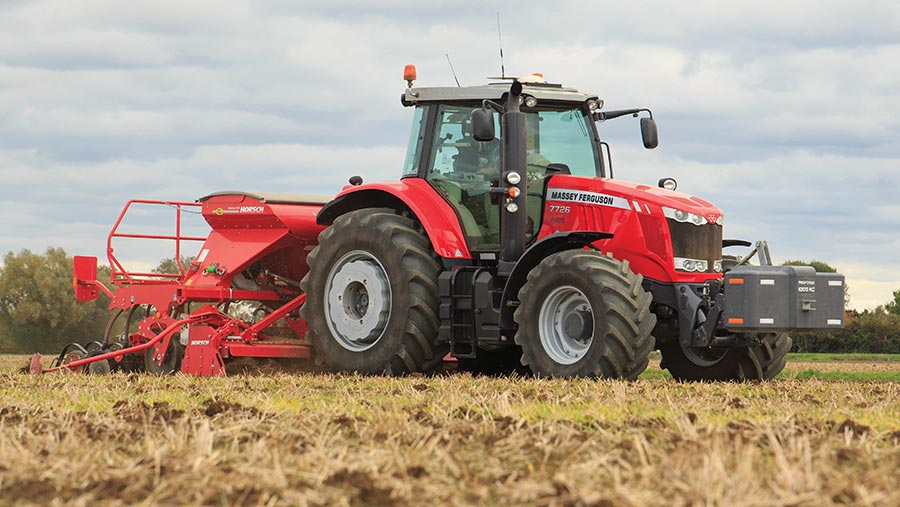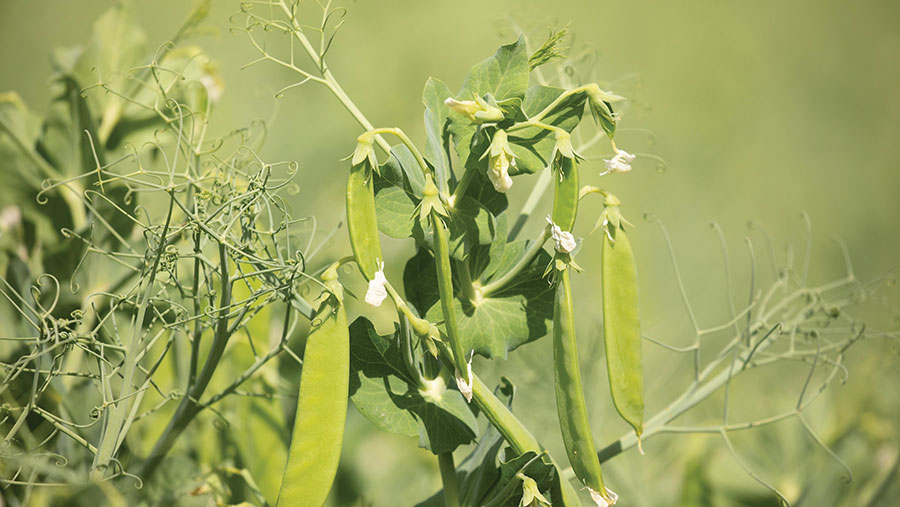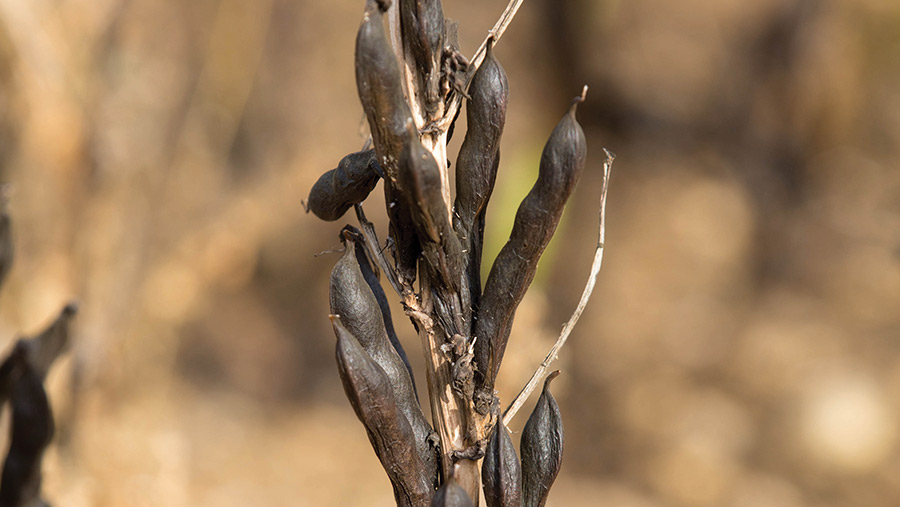Arable farmers outline their crop rotation tweaks for 2023-24
 © Tim Scrivener
© Tim Scrivener While the final word on the current season will become apparent after the combine has finished, some conclusions can already be drawn, and plans begin to be formalised.
What might be changing on each of our Arable Insights farms for the coming season?
See also: Why it may be time to drop susceptible winter wheat varieties
East Anglia: James Sills
With barley yellow dwarf virus symptoms evident in James Sills’ wheat, he is carefully considering how to react this autumn.
“My big mistake this year was not doing more to spray for barley yellow dwarf virus (BYDV). I’m not sure what the yield hit will be, but it’s going to be much more than it would have cost to spray insecticide.”
Decision support tools suggested aphid pressure was over threshold, he admits.
“But we were also quite a long way over threshold the previous two seasons, and yet Niab found very little effect from an October drilling.”
The kneejerk reaction would be to spray more next autumn, but James is keen to understand what the yield hit is, and then contextualise how often that penalty is likely.
“I’d also like to do a bit of reading about just how damaging an autumn pyrethroid is. I’d told myself no insecticides at all, if possible, but perhaps I’ve got to be a bit more nuanced about differentiating between lesser and greater harms with insecticides.”
Blackgrass control, while not disastrous, has only been borderline acceptable this season, James says.
“We stuck mostly to older chemistry and generics, drilled early and it was dry. However, visiting Harlow Agricultural Merchants trials has solidified the idea that spending more does produce better results.
“The way our rotation works is these fields will be back in wheat in two years, so we will probably spring-crop the three worst fields out of 50, and then spend more on blackgrass chemistry on the rest.”
After seeing a neighbour have success with drilling later while spending a little more on chemistry, he was considering whether to drill from 10 October rather than 1 October.
However, on further reflection his focus will be to avoid using deep, non-inversion tillage when drilling in that earlier window.
“That’s the most damaging combination to avoid on higher-risk blackgrass fields.”
Variety choice for this autumn is currently planned to be one-third each of Champion, Dawsum and Extase, with Gleam the loser from his current choices.
“It might just be that our farm-saved Gleam seed has lost its vigour, but it hasn’t really filled out and looks a bit thin, which is disappointing in a year when we’ve had lots of chances to build biomass.”
The final split will be dependent on Extase making milling specification after applying 300kg/ha of N this season.
“If we struggle to make the spec that will make us think a little bit more. Like everyone, we’re on the lookout for a good new Group 1 variety to replace the Zyatt we’ve previously grown.”
West: Mark Wood
Relatively minor tweaks to the current cropping mix are expected at Clay Farms this autumn, with risk a key consideration.
The oilseed rape area was down after the dry conditions meant planting was only possible in the first week of September.
“It was too high risk,” farm manager Mark Wood explains.
“It has to go into the right conditions. If we get those this year the area might increase, but it’s all down to that initial period, because insecticides don’t work, so it has to get up and grow to get beyond the flea beetles.”
All of the oilseed rape area is in Clearfield varieties because of brassica weed concerns.
“It is too much of a risk to have some Clearfield and some non-Clearfield, as you know a mistake will happen at some point.”

Combining peas © Tim Scrivener
Any increase in oilseed rape will likely come at the expense of oats, which are now mostly grown for the less-risky local chicken feed market than for milling, or winter barley, which is grown on heavier land to extend the rotation.
He is also experimenting this year with growing white peas for a local pigeon food manufacturer, rather than large blues, which are higher risk to harvest and meet the colour specifications.
On heavier land, he is finding success with spring beans.
In the feed wheat grown for the local livestock feed market, good septoria resistance is the key criteria for the farm.
The variety most at risk of being replaced is Costello.
“It’s always done well for us, but I think there’s possibly better. We have an area of Dawsum this year, and if it yields well, we’ll likely grow a much larger area of it and drop Costello.”
Graham suits the farm’s earliest-drilled blocks, and Extase fits the last-drilled fields and provides good disease resistance to manage fungicide spend.
“With input prices having gone up so much, we’re having to look carefully at that,” Mark says.
But specific weight concerns have put him off growing Champion.
“We’ve had specific weight issues on lighter ground in some years and, while we could blend it with another variety, it is a hassle we don’t need.”
South West: Emma Foot
Growing winter beans in place of some winter oats is the main change Emma Foot is considering on her Dorset farm.
“We’ve got quite a lot of grassweeds – blackgrass, Italian ryegrass and some sterile brome. We’ve sprayed some patches out, but it is looking a bit untidy,” she says.
“We like growing oats, but if you’re getting lots of grassweeds coming through, you need to consider alternatives to help manage them better.”
Winter beans would provide alternative chemistry and delay drilling compared with winter oats.
“It’s not set in stone yet, and will also depend on how successful we are with oilseed rape drilling.
“We want to grow oilseed rape, but if it is dry then it is just a waste of time and money. In that case, we would definitely have more winter beans.”

Feed beans © Tim Scrivener
With milling wheat premiums pushing £60/t in June, there’s also a temptation to grow a Group 1 variety such as Skyfall in place of Extase.
Insitor and new RAGT variety Highgrove, awned like Skyfall, are both also under consideration for the drought-prone light land fields, Emma says.
“We think on our soils we need to be growing more of a drought-intolerant variety.”
Scotland: Amy Geddes
Next year’s rotation at Wester Braikie Farms will be finalised once about 40ha of prospective land for seed potatoes has been tested for potato cyst nematode, explains Amy Geddes.
“Whether we get the land passed or not for tatties, that dictates how much spring barley we grow. If we have a lot of spring barley, that dictates whether we might put in a second wheat or let more ground for peas and beans.”
With potato cyst nematode an issue on the farm, Amy keeps potatoes to no more than once in six years, and is also using Bento oil radish cover crops for its potential biofumigant properties.
She is also trialling a chitin-containing compost made from seashells as another potential biocontrol.
The soft wheat variety Swallow is being dropped after this season in favour of the hard feed variety Dawsum, which is being grown on the farm in a small block this year to home-save for next season.
Skyscraper will remain the other wheat variety.
“Although it is sold as feed, virtually all of it goes for distilling. We’re hoping the big distilleries invest to make sure their plant can cope with the more resilient varieties we are going to have to grow in the future.”
Northern Ireland: Simon Best
A subtle tweak to the rotation at Acton House Farm is changing the proportion of winter-sown and spring-sown oats to 50:50, rather than 75:25.
“That allows us to delay drilling winter barley by about a week to the last week of September. We were caught last year with BYDV, but drilled later this year, to better effect,” Simon Best explains.
Isabel spring oats have performed consistently almost on a par with winter varieties, he says.
He’s trialling Husky winter oats to compare with his mainstay, Mascani, this season.
Husky produces less biomass than Mascani, which can be a problem to ripen and harvest, but is perhaps less resilient to cold weather.

© MAG/Richard Allison
“We’re keen to look at other varieties, but our bonuses for quality are important.”
Another change will be to move away from growing only Graham, as it is starting to break down to yellow rust.
Instead he plans to grow a range of wheat varieties, including Extase, Mayflower and possibly Champion alongside Graham.
Down the line, the farm may have to make a difficult decision about land currently in environmental stewardship schemes.
With a new scheme for Northern Ireland still not launched and his current scheme ending in December, next year could be the first time in 23 years the farm is not in a scheme, Simon says.
“It’s frustrating – we’ve established strong relationships with the RSPB, Ulster Wildlife and the Woodland Trust, which have supported us and monitored the performance of some of the habitats.
“We have three red list species which weren’t here three or four years ago.”
With the new Farming with Nature scheme unlikely to be fully rolled out until 2025 or 2026, there’s potentially a two-year void where difficult decisions about current habitats will have to be made, he says.
Midlands: Will Oliver
The potential loss of all three seed treatments for maize could see major changes to Will Oliver’s rotation, as the crop forms about one-quarter of his cropping.
“A lot depends on changes to legislation. If we lose these seed treatments, we will definitely reduce our maize area,” he says.
What to replace it with is less clear. “Oilseed rape still doesn’t seem viable. It’s sad to say profitable break crops are not screaming out to me.
“I expect to increase our Vespa winter bean area, as they look well this year and suit our direct-drilling system, but there’s a limit to how much we can increase. I’m inclined to also revert to second wheats on good wheat ground.”
There might be changes in both varieties and target market for wheat.
“Skyfall is coming to the end in its robustness in our rotation, and with supply of crop protection products possibly an issue in a high-pressure year, sticking to cleaner varieties and feed wheats is probably the direction we’re heading in.”
North: James Pick
The introduction of a small area of a full-season cover crop is the main change James Pick is making at Airy Hill Farm in North Yorkshire.
On a heavy land block, it has proved tricky to establish spring barley or spring oats where oilseed rape isn’t grown in two out of the past five seasons.
So, with potential funding from Mid Tier Stewardship available for cover crops, James is planning to plant one field out of the six in the block with an overwintered cover crop and follow it with a second summer cover crop.
“Otherwise, the rotation will remain the same, with one or two winter wheats, an overwintered cover into spring beans, wheat again, then winter barley to create an early entry into oilseed rape.
“On our potato land we will factor potatoes in once in seven or eight years.”
Three new wheat varieties are being considered.
Ultimatum, a Group 2 that has high untreated yields, particularly in the North, will be grown as a standalone variety, while Redwald, another high-yielding variety, will be added to a blend of Extase, Dawsum, Gleam, Theodore and Revelation, along with Mayflower.
James is also planning a blend of three hybrid oilseed rape varieties, Duplo, PT312 and Vegas, after seeing a positive effect with a blend this year. Duplo will also be grown as a standalone variety on half the area, he says.
South East: Doug Wanstall
With oilseed rape requiring a good deal of luck and inputs to grow reliably, the remaining 50ha will be replaced this autumn with a plan to grow continuous cereals with a constant understorey of white clover, says Doug Wanstall of Bank Farm, Ashford.
“Oilseed rape doesn’t really fit with our desire to not use insecticides,” he adds. “Nor is it a host for the arbuscular mycorrhizae fungi we are trying to develop in our soils.”
So, along with a plan to grow 80ha of lucerne and more multispecies cover crops for grazing with sheep and cattle, he will attempt to establish white clover on that 50ha this autumn as soon as possible after harvest, before direct-drilling with spring barley.
That will be followed by winter wheat with compost, oats, winter wheat again and back into spring barley, with the living mulch constantly present.
“The theory is that we are getting enough diversity into the rotation because we are building up lots of soil life and with lots of different plants in the rotation and living roots all the time,” Doug says.
“So I don’t think we will run into any problems with take-all or grassweeds.”
In his wheat, Dawsum is being added to his current blend of Extase, Zyatt and Crusoe.
“We’re no longer aiming for the milling market, but I want to keep the adaptation and endophytes we’ve built up on the seed from home-saving, rather than starting again completely.”

